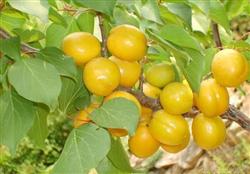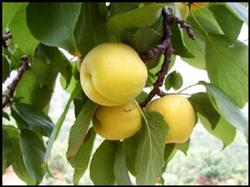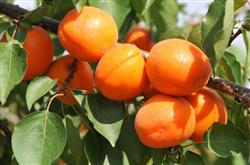Production technology of green fruit and early-maturing apricot

1. Requirements for ecological environment of green fruit extra precocious apricot 1. Site selection: the production base of green fruit should have a good ecological environment, so in the selection of garden site, we should choose the environment with fresh air, pure water quality and unpolluted soil, far away from industrial areas and traffic roads as far as possible, or in the upwind of cities, industrial areas and traffic roads, and require that the surface water and underground water quality should be pollution-free. The content of soil elements is suitable, the soil structure is good, and the soil should have higher fertility. 2. Environmental quality standards: environmental pollution mainly refers to the pollution of the source air, water quality, soil and other conditions. The air quality standards should adopt the first-class standards listed in the national air quality standard GB3095--B2, especially for sulfur dioxide, nitrogen oxides and total suspended particulates, the water quality should meet the GB--5084--92 farmland irrigation water quality standards, and the contents of heavy metal ions such as mercury, lead, cadmium, chromium, arsenic, chloride and fluoride should be less than 1/10000000. Heavy metals and harmful salts in soil should be limited according to the depth of soil types and tree species. 3. Control pollution in production: at present, green food is divided into AA grade and A grade in our country. The former is not allowed to use any chemical synthetic pesticides and fertilizers in the production process, while the latter allows limited use of prescribed chemical pesticides and fertilizers. At present, it is difficult to develop AA grade, and A grade is more suitable for the national conditions. 3.1 Integrated control of extra-precocious apricot: the occurrence of diseases and insect pests in the process of apricot production is inevitable. In order not to cause pollution to the environment and fruits and to maintain the balance of the agro-ecosystem, it is necessary to reduce the use of chemical pesticides as far as possible, and allow the use of plant pesticides, biological pesticides and microbial pesticides. It is strictly forbidden to use pesticides that are highly toxic, highly toxic, highly residual or carcinogenic, teratogenic and mutagenic. If the production is necessary, the production base is allowed to use some organic synthetic chemical pesticides to a limited extent, but the drugs must be used in strict accordance with the operating rules and methods for the use of pesticides. 3.2 rational fertilization: the main fertilizers used in the production of green fruits are farm manure and non-chemically synthesized commercial fertilizers, which are not used correctly in production. Different application time and fertilization methods will inevitably cause pollution to the soil, air and water. The extensive use of nitrate nitrogen fertilizer can increase the nitrate content in the soil and lead to the increase of nitrate content in the fruit. It has a bad effect on the fruit quality and reduces the fruit quality. For this reason, we should vigorously advocate the application of more organic fertilizers, adopt formula fertilization and increase the application of trace element fertilizers, and never overuse nitrogen fertilizers. For chemical fertilizers that are allowed to be limited, such as urea, potassium sulfate and potassium dihydrogen phosphate special fertilizer for fruit trees, it should be mixed with organic fertilizer and microbial fertilizer, and the ratio of organic nitrogen to inorganic nitrogen is 1:1. When used as topdressing, it should be discontinued 30 days before fruit harvest. 2. Production technology of green fruit extra-precocious apricot 1. Select high-quality strong seedlings, seedlings should try to choose complete root system, stout branches, shiny skin color, large and full buds, about 100cm in height, 1.2cm in thickness, and no quarantine diseases and insect pests as cultivation objects. 2. Planting freeze-resistant and high-yielding extra-precocious apricot varieties, such as Golden Sun, Hongfeng, New Century, Qin King Apricot and so on. 3. With the rational allocation of pollination trees, the new varieties with frost resistance and high yield have a certain ability of self-pollination, but the effect of cross-pollination is better. 4. Density and tree shape, the planting density of extra-precocious apricot is 3m per 667 square meters (4murmur5m per mu), 2m (3Mube 4m), 83Muel 111 plants per 667 square meters. The tree shape is free spinning "V" shape. 5. Planting, digging big pit, generally deep 60cm, wide 80cm, applying sufficient base fertilizer before planting, applying rotten organic fertilizer 3000--5000kg, ternary compound fertilizer 50kg about 667m2, mixing fertilizer with topsoil, backfilling and planting, strictly forbidding seedling root contact with fertilizer, irrigation before planting, setting dry height after planting, spinning shape setting dry height to 70--80cm, V shape setting dry height to 50cm, apricot tree after growing. Pay attention to sprouting. 6. Pruning, the young trees are mainly pruned in summer, which can control the growth and promote the branching. Cultivate a firm and high-yielding skeleton and expand the crown rapidly. The extended branches of backbone branches are generally carried out once a year, when the center of the new shoots is to 40--50cm, and when other vigorous shoots are about 30cm. In September, the opening angles of backbone branches with small angles, branches and drawing branches with improper orientation of upright branches are adjusted. When cutting, the extended branches of the backbone branches were cut short 40--50cm, the medium and long fruit branches were cut lightly, the dense branches were removed, and the erect strong branches and competitive branches were removed. For the pruning of the fruiting tree, the strong buds and shoots in the cutting saw should be wiped off the back of the big branches in time in summer, and the vigorous shoots should be sent out, and the opening angles of different and pulling measures should be taken to control their growth, cultivation and utilization. In winter pruning, we should combine cutting, releasing, thinning and shrinking, pay attention to the renewal of reserve branches and perennial branches, remove overdense and overprosperous branches, open the light path, promote the growth of internal chamber branches, cut middle and long fruit branches, retract the weak and drooping branches for many years, and control the fruit parts to move upward and outward. Maintain the crown structure and the fruiting ability of the perennial branch group, keep the tree potential moderate, and adjust the relationship between growth and fruit. 7. Flower and fruit management, early apricot growth period is short, fruit setting rate is high, should be timely fruit thinning to increase fruit, increase uniformity, in general, it is appropriate to leave fruit gap 5--8cm. 8. pest control, apricot main diseases and insect pests are aphids, red spiders, shell insects, scab, perforation, commonly used drugs are 10% imidacloprid, pyrethroid pesticides, 65% of zinc, polyantimycin, agricultural resistance 120 and so on.
- Prev

Causes and countermeasures of rotten apricot fruit in greenhouse
The reason for fruit rot is lack of light in the greenhouse for a long time in cloudy or rainy or snowy days, and there is a lot of dust on the surface of the greenhouse film, resulting in insufficient light and excessive humidity in the greenhouse. Young fruit grows in dark and moist air for a long time, which is easy to cause rotten fruit. The indoor temperature in the greenhouse is too high in the young fruit stage of apricot, if the indoor temperature exceeds 28 degrees Celsius.
- Next

Cultivation techniques of plum and apricot
1. High standard garden 1. Garden selection: apricot is a kind of tree species that is tolerant to early and intolerant to waterlogging, barren and fond of light, and is vulnerable to late frost at flowering stage. Therefore, the founding of the people's Republic of China should be selected in the back Phoenix to the sun, the terrain is higher, good drainage deep soil plot. 2, choose strong seedlings: high-quality strong seedlings ensure the survival rate and high yield.
Related
- Moge, come on! The staff of the peasant association in the producing area of cantaloupe were frightened when the crowd gathered.
- Causes and Solutions of low Fruit setting rate of Apple
- Symptoms and control measures of passion fruit virus disease
- Fruit growing lesson: how do apple orchards keep high yields?
- Can you build orchards in the mountains? What are the pros and cons?
- How to manage the coloring period of Crisson grape?
- This paper introduces the processing technology of two kinds of fig products.
- How much is a month for retired teachers in rural areas by 2020?
- How can strawberry planting increase sugar content? We should pay attention to management in many aspects.
- What are the cultivation techniques on how to improve the yield of golden fruit?

